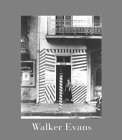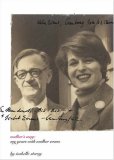
See larger photo
| Walker Evans
     
[Click on the appropriate flag to buy the book] | Product Details
Hardcover
332 pages
Princeton University Press
Published 2000
Amazon.com
In 1926 Walker Evans dropped out of Williams College and arrived in Paris to launch his career as a writer. Though his life there revolved around the renowned Shakespeare and Company bookstore, a mixture of introversion and disdain for American culture kept him at a remove from the now famous expatriate circle of the era, the Fitzgeralds, Hemingway, the Murphys, and Joyce among them. He spent most of his time abroad alone and picked up his camera from time to time to document his immediate world, making images of his boarding room and his own shadow against a wall. When he returned to the States, Evans began to dedicate more time to his hobby, and by the end of his long career had established himself as one of the most important modernist photographers. Walker Evans, the catalog to the Metropolitan Museum of Art's retrospective of Evans's work (exhibiting February to May 2000, then moving on to other venues), is proof that his choice to abandon writing for photography left the cultural world richer. It is also arguably the best book available on the photographer and his images.
The Metropolitan possesses the bulk of Evans's archive of prints, negatives, diaries, working notes, letters, and other writings. In the process of planning the show, its curators discovered hundreds of previously unknown negatives stored at the Library of Congress. From this vast source, they constructed the show and its companion book. The catalog's introductory essays by such writers as Maria Morris Hambourg, head of photography for the Met, sketch the biographical details of Evans's life and explore works like his New York subway portraits in depth. But the real treat is to browse the nearly 200 plates, each reproduced from vintage prints in the museum's archive and private collections. Evans's early work focused on New York City--the proverbial bright lights of Broadway, the carnival atmosphere of Coney Island, the clutter of workers and shoppers and cars and advertisements in its streets. Soon he fanned out, photographing main drags and battered buildings in upstate New York and Pennsylvania. He also explored the people of Havana, Cuba, and the rural American South in some of his best-known work. By the mid-1970s, Evans was working in color, but his imagery remained consistent: signs, architecture, and seemingly inconsequential details like a Peg-Board full of kitchen utensils dominate. Arriving at the close of this book, readers can only thank the fates that Evans gave up his ambitions as a writer to devote himself wholly to his "left-handed hobby" of photography. --Jordana Moskowitz
From Library Journal
Walker Evans, the Metropolitan Museum of Art's catalog to its current major retrospective, is a rock-solid work providing biographical, historical, and visual accounts of the artist's life and work. Hambourg, an assistant curator in the museum's Department of Photography, edited this big book with the straightforward approach that Evans employed in his art. Careful reproduction of well-known black-and-white and little-known color photographs by Evans forms the heart of the volume. There are... read more
Book Description
A tenant farmer's deprivation-lined face. Antebellum homes that have seen better days. The display windows of small-town main streets. The early subway commuter. Billboards. The images made by photographer Walker Evans (1903-1975) are icons of national identity that have shaped Americans' views of themselves and directly influenced important currents of modern art. This major catalogue--published to accompany a retrospective exhibition originating at The Metropolitan Museum of Art and traveling to San Francisco and Houston--presents the full range of Evans's work, from his 1920s black-and-white street scenes of anonymous urban dwellers to the color photographs of signs and letter forms from his final years.
Soon after he returned from Paris to New York City in 1927, Evans began contributing to the development of American photography. He captured the substance of people and buildings with a spare elegance t |
Manuel Alvarez Bravo, Henri Cartier-Bresson, and Walker Evans.
Documentary and Anti-Graphic Photographs: A Reconstruction of the 1935 Exhibition at the Julien Levy Gallery in New York.
Alvarez Bravo (Photographer); Henri Cartier-Bresson (Photographer); Walker Evans (Photographer); Daniel Giradin (Essay); & Ian Jeffrey (Essay) |  |
|
Many Are Called
Walker Evans (Photographer) |  |
|
Walker Evans: Signs
Walker Evans (Photographer); Andrei Codrescu; & J. Paul Getty Museum |  |
|
Walker Evans: Cuba
Walker Evans (Photographer); Andrei Codrescu; & Judith Keller (Introduction) |  |
|
Incognito: Limited Edition
Walker Evans (Photographer); & Leslie Katz (Compiler) |  |
|
Walker Evans: Photographs for the Farm Security Administration, 1935-1938: A Catalog of Photographic Prints Available from the Farm Security Admini
Walker Evans (Photographer); & Library of Congress |  |
|
Walker Evans: Florida
Walker Evans (Photographer); & Robert Plunket |  |
|
|
Walker Evans: Polaroids
Walker Evans (Photographer); & Jeff L. Rosenheim |  |
|
Documenting America, 1935-1943 (Approaches to American Culture, No 2)
Carl Fleischhauer (Editor); Beverly W. Brannan (Editor); & Lawrence W. Levine (Editor) |  |
|
Walker Evans Simple Secrets: Photographs from the Collection of Marian and Benjamin A. Hill
Ellen Fleurov; Marian Hill; & High Museum Of Art |  |
|
|
|
American Photographers of the Depression: Walker Evans, Dorothea Lange and the FSA Photographers (Photofile)
Charles Hagen |  |
|
Walker Evans: American Photographs
Lincoln Kirstein; & Walker Evans (Photographer) |  |
|
Perfect Documents: Walker Evans and African Art, 1935
Virginia Lee-Webb; & Virginia-Lee Webb |  |
|
|
Walker Evans (Photofile)
Gilles Mora (Introduction); & Walker Evans (Photographer) |  |
|
|
Walker Evans: A Biography
Belinda Rathbone |  |
|
|
|
|
Walker Evans (Phaidon 55 S.)
Luc Sante; & Walker Evans |  |
|
Walker’s Way: My Years with Walker Evans
Isabelle Storey (Author) |  |
|
The Last Years of Walker Evans: A First-Hand Account
Jerry L. Thompson; & Walker Evans |  |
|
Reading American Photographs: Images As History: Mathew Brady to Walker Evans
Alan Trachtenberg |  |
| |

